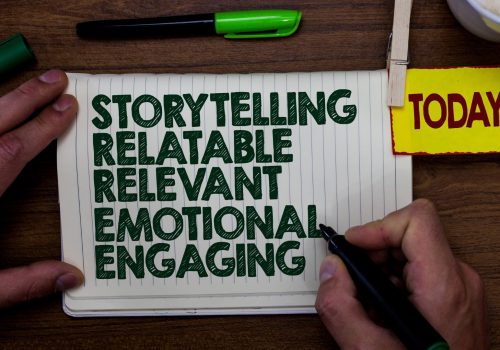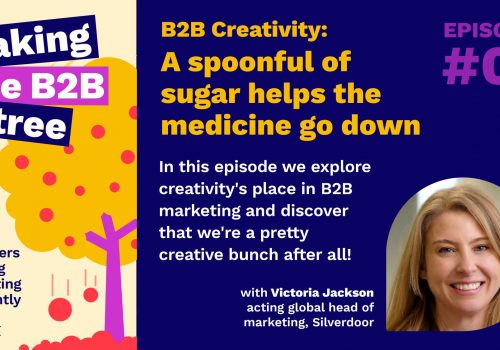B2B communications is going through an exciting transition thanks to the explosion of AI. Content is becoming easier and less expensive to create, meaning brands can get their stories out in the world faster than ever. With a touch of a button, generative AI can produce blog articles, social media posts, video concepts and more. In 2024, 63% of marketers said that most of their content would come from AI and nearly seven out of ten marketers are expecting it to play a bigger role in their work in the future. However, just because there is more content in existence doesn’t mean there is more meaningful content.
Why does storytelling need to be strategic?
Audiences are scrolling faster than ever before due to content overload; there’s too much information to sift through. And, as a result, it’s becoming increasingly difficult to stand out against the competition in B2B, especially when every brand has a solution that is ‘innovative’ and ‘customer first’. Add to that the fact that B2B buying is becoming more complex with longer sales cycles and more stakeholders involved in decision-making, and marketers are left with a real challenge on their hands.
This is where the word trust comes into the equation. Audiences want to trust the brands they work with, while brands need to find ways to earn that trust. It’s no surprise that LinkedIn’s 2025 Benchmark report found trust to be the clearest path to ROI and now the growth engine in B2B. Storytelling is one of the most effective ways to build it. That’s why storytelling needs to be strategic. It’s not just about creating content for the sake of it; it’s about crafting the right story, for the right audience, at the right time and aligning it to clear business objectives.

The seven ingredients of strategic storytelling
Here are the seven essential elements you can apply in your marketing communications to ensure your stories are building trust and delivering impact.
1: Objective – the base of any good story
This is what defines the purpose of your story. It’s not just about what you want to say but what you want your audience to think, feel or do as a result. That could be building credibility, educating the market, shifting perception, or deepening emotional connection. In short, it has to be intentional. Without a clear objective, your story risks becoming just another piece of content in the noise.
2: Messaging – the narrative edge
Messaging is what makes your story both memorable and meaningful. Too often brands focus heavily on product features, technical specs and industry jargon. However, strategic storytelling requires more than just information, it demands resonance. Not only should it reflect your audience’s world (e.g. what are they struggling with? What do they care about?) but it needs to define why your brand matters. Keeping it consistent across all channels will also ensure it delivers clarity to your audience across multiple touch points.
3: Spokespeople – adding the human layer
In B2B, it can be easy to default to brand voice but audiences connect deeply with real people such as company founders, internal experts and even customers. These voices are speaking from real world experience and make what your brand’s message more believable. Think about a brand saying ‘we’re innovative’ compared to a product lead explaining how they solved a client challenge. One is a claim; the other is a story. With technical, layered subjects, spokespeople can also help humanise complex topics making them accessible and understandable.
4. Data – building credibility through insight
Data is one of the most powerful tools in B2B storytelling as it adds depth, originality and authority when used in the right way. Using internal insights including usage stats, product performance metrics, or survey results, can back up your stories with tangible proof points. Crucially, it can also differentiate your brand too. By using market research such as commissioned studies, customer interviews and industry benchmarking, you can find insights outside your business that are going to be relevant, interesting and unique to your customers. One strong data point can then be reused across the entire content universe.
5. Relevance – being meaningful
Relevance is about making your story stick. This is achieved by understanding what matters to your audience right now including what challenges they’re facing and what language they’re using. You can do this by monitoring the media, conducting forums, getting insights from the customer success team and looking at user generated content (B2B pros use TikTok too). However, it’s not just about being timely; it’s also about being meaningful. A brilliant story in the wrong place won’t get seen, however, distributing the right format, using the right channel, will drive real impact.
6. Measurement – creating a feedback loop
Measurement is what turns storytelling into strategy. As marketers, we understand the challenges associated with measuring in a meaningful way, especially when there are an abundance of metrics to report on. But, the good news is, measurement tools are coming on leaps and bounds meaning we can evaluate performance and understand how stories are performing. By knowing what stories are landing, what formats are working and what messages are sticking means changes can be made in real time to drive better results. Treat measurement as part of the creative process and not the end of it. [Top tip: download our Demystifying Measurement report for more on this].
7. AI – a tool not a storyteller
AI might be changing the way we create content but it shouldn’t be changing the essence of our stories. There are many benefits to using AI to enhance content – it can spot patterns, help with personalisation, speed up production – but it can’t replace human judgement, emotional nuance or brand authenticity. Strategic storytelling still needs a human voice. Your audience wants to hear from people who understand their world, not just algorithms trained on it because in B2B, where trust and credibility are everything, your story still needs to feel human.
Audience trust is synonymous with long term growth
As established, when storytelling is done right, strategically and with purpose, it builds audience trust. In B2B, that matters more than ever. Audiences aren’t making snap decisions; they’re gathering information, weighing up risk, and looking for signals of credibility at every stage. And strategic storytelling helps you show up consistently across that journey.
It gives your brand a voice that’s not just informative, but relatable. It’s what makes your message stick. It’s what makes your brand feel familiar. And it’s what builds the kind of trust that influences decisions.

Access more storytelling recipes in The B2B Natural Storytelling Cookbook. Download here.











